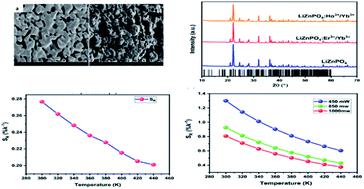Our official English website, www.x-mol.net, welcomes your feedback! (Note: you will need to create a separate account there.)
Highly sensitive optical temperature sensing based on pump-power-dependent upconversion luminescence in LiZnPO4:Yb3+–Er3+/Ho3+ phosphors
RSC Advances ( IF 3.9 ) Pub Date : 2021-09-17 , DOI: 10.1039/d1ra06049j Kamel Saidi 1 , Wajdi Chaabani 2 , Mohamed Dammak 1
RSC Advances ( IF 3.9 ) Pub Date : 2021-09-17 , DOI: 10.1039/d1ra06049j Kamel Saidi 1 , Wajdi Chaabani 2 , Mohamed Dammak 1
Affiliation

|
In this work, various LiZnPO4:0.5 mol% Ln3+ (Ln = Ho, Er) phosphors with different Yb3+ ion doping concentrations were synthesized by a sol–gel/Pechini method. X-ray diffraction (XRD) and scanning electron microscope (SEM) techniques were used to evaluate the phase and morphology of the samples. The UC process was mentioned as the typical emission peaks of Er3+ and Ho3+. For Er3+ and Ho3+, different optical temperature sensing methods are included. The Boltzmann distribution was accompanied by the fluorescence intensity ratio (FIR) for the two green Er3+ emissions originating from thermally-coupled levels. The effect of pump power on sensor sensitivities was extensively studied. The temperature uncertainty is also evaluated. The red and green emissions generated from non-thermally-coupled levels were used for temperature sensing in the Ho3+-activated LiZnPO4. High sensitivities were obtained in the phosphors, and the LiZnPO4:Yb3+/Ho3+ showed the largest absolute sensitivities. LiZnPO4:Yb3+–Er3+/Ho3+ phosphors may be useful in the development of new luminescent materials for optical temperature sensing.
中文翻译:

LiZnPO4:Yb3+–Er3+/Ho3+ 荧光粉中基于泵浦功率依赖上转换发光的高灵敏度光学温度传感
在这项工作中,通过溶胶-凝胶/Pechini 方法合成了具有不同 Yb 3+离子掺杂浓度的各种 LiZnPO 4 :0.5 mol% Ln 3+ (Ln = Ho, Er) 荧光粉。X射线衍射(XRD)和扫描电子显微镜(SEM)技术用于评估样品的相和形貌。UC 过程被提及为Er 3+和Ho 3+的典型发射峰。对于Er 3+和Ho 3+,包括不同的光学温度传感方法。玻尔兹曼分布伴随着两种绿色 Er 3+的荧光强度比 (FIR)源自热耦合能级的排放。泵浦功率对传感器灵敏度的影响已被广泛研究。还评估了温度不确定性。由非热耦合能级产生的红色和绿色发射用于在 Ho 3+活化的 LiZnPO 4中进行温度传感。在荧光粉中获得了高灵敏度,并且LiZnPO 4 :Yb 3+ /Ho 3+显示出最大的绝对灵敏度。LiZnPO 4 :Yb 3+ –Er 3+ /Ho 3+荧光粉可用于开发用于光学温度传感的新型发光材料。
更新日期:2021-09-17
中文翻译:

LiZnPO4:Yb3+–Er3+/Ho3+ 荧光粉中基于泵浦功率依赖上转换发光的高灵敏度光学温度传感
在这项工作中,通过溶胶-凝胶/Pechini 方法合成了具有不同 Yb 3+离子掺杂浓度的各种 LiZnPO 4 :0.5 mol% Ln 3+ (Ln = Ho, Er) 荧光粉。X射线衍射(XRD)和扫描电子显微镜(SEM)技术用于评估样品的相和形貌。UC 过程被提及为Er 3+和Ho 3+的典型发射峰。对于Er 3+和Ho 3+,包括不同的光学温度传感方法。玻尔兹曼分布伴随着两种绿色 Er 3+的荧光强度比 (FIR)源自热耦合能级的排放。泵浦功率对传感器灵敏度的影响已被广泛研究。还评估了温度不确定性。由非热耦合能级产生的红色和绿色发射用于在 Ho 3+活化的 LiZnPO 4中进行温度传感。在荧光粉中获得了高灵敏度,并且LiZnPO 4 :Yb 3+ /Ho 3+显示出最大的绝对灵敏度。LiZnPO 4 :Yb 3+ –Er 3+ /Ho 3+荧光粉可用于开发用于光学温度传感的新型发光材料。


























 京公网安备 11010802027423号
京公网安备 11010802027423号